Control module JAGUAR XFR 2010 1.G Owner's Guide
[x] Cancel search | Manufacturer: JAGUAR, Model Year: 2010, Model line: XFR, Model: JAGUAR XFR 2010 1.GPages: 3039, PDF Size: 58.49 MB
Page 117 of 3039

DTC Description Possible Causes Action Sensor or Left Rear
Vertical Acceleration
Sensor or Right Rear
Vertical Acceleration
Sensor supply partial
short to other circuit
or ground
Left Front Vertical
Acceleration Sensor or
Right Front Vertical
Acceleration Sensor or
Left Rear Vertical
Acceleration Sensor or
Right Rear Vertical
Acceleration Sensor
internal failure
Internal control
module failure U0001-88
High speed CAN
communication
bus - Bus off
Lost Communication
With Engine Control
Module (ECM) (CAN
Bus circuit fault)
Check Engine Control Module for stored DTCs. Refer to the
electrical circuit diagrams and check CAN Bus circuit for faults,
check CAN circuits for open circuits or shorts to power, ground
or other circuits U0100-00
Lost
Communication
With ECM/PCM A
- No sub type
information
Missing message from
ECM
Check Engine Control Module for stored DTCs. Refer to the
electrical circuit diagrams and check CAN Bus for circuit fault U0101-00
Lost
Communication
with TCM - No
sub type
information
Lost Communication
with Transmission
control module (TCM)
(CAN Bus circuit fault)
Check Transmission Control Module for stored DTCs. Refer to
the electrical circuit diagrams and check CAN Bus for circuit
fault U0103-00
Lost
Communication
With Gear Shift
Control Module
A - No sub type
information
Lost Communication
With Gear Shift
Module (GSM) (CAN
Bus circuit fault)
Check Gear Shift Module for stored DTCs. Refer to the
electrical circuit diagrams and check Can Bus for circuit faults U0121-00
Lost
Communication
With Anti-Lock
Brake System
(ABS) Control
Module - No sub type information
Lost Communication
With Anti-Lock Brake
System (ABS) Control
Module (CAN Bus
circuit fault)
Check Anti lock Brake System Control Module for stored DTCs.
Refer to the electrical circuit diagrams and check Can Bus
circuit to Anti lock Brake System Control Module for circuit
faults U0132-00 Lost
Lost Communication
Check Air Suspension Control Module for stored DTCs. Refer to Communication With Suspension With Air Suspension the electrical circuit diagrams and check CAN Bus circuit to Air Control Module Control Module (CAN Suspension Control Module for circuit faults A - No sub type Bus circuit fault information U0136-00
Lost
Communication
With Differential
Control Module -
Rear - No sub type information
Lost Communication
With Rear Differential
Control Module (CAN
Bus circuit fault)
Check Rear Differential Control Module for stored DTCs. Refer
to the electrical circuit diagrams and check Can Bus circuit to
Rear Differential Control Module for circuit faults U0140-00
Lost
Communication
With Body
Control Module -
No sub type
information
Lost Communication
With Body Control
Module (Front Smart
Junction Box) (CAN
Bus circuit fault)
Check Body Control Module for stored DTCs. Refer to the
electrical circuit diagrams and check CAN Bus circuit to Body
Control Module for faults U0142-00
Lost
Communication
With Body
Control Module
B - No sub type
information
Lost Communication
with rear smart
junction box (CAN Bus
circuit fault)
Check Rear Smart Junction Box for stored DTCs. Refer to the
electrical circuit diagrams and check Can Bus circuit to Rear
Smart Junction Box for faults U0155-00
Lost
Communication
With Instrument
Panel Cluster
Lost Communication
With Instrument Panel
Cluster (IPC) Control
Check Instrument Panel Cluster for stored DTCs. Refer to the
electrical circuit diagrams and check CAN Bus to Instrument
Panel Cluster for circuit fault
Page 118 of 3039
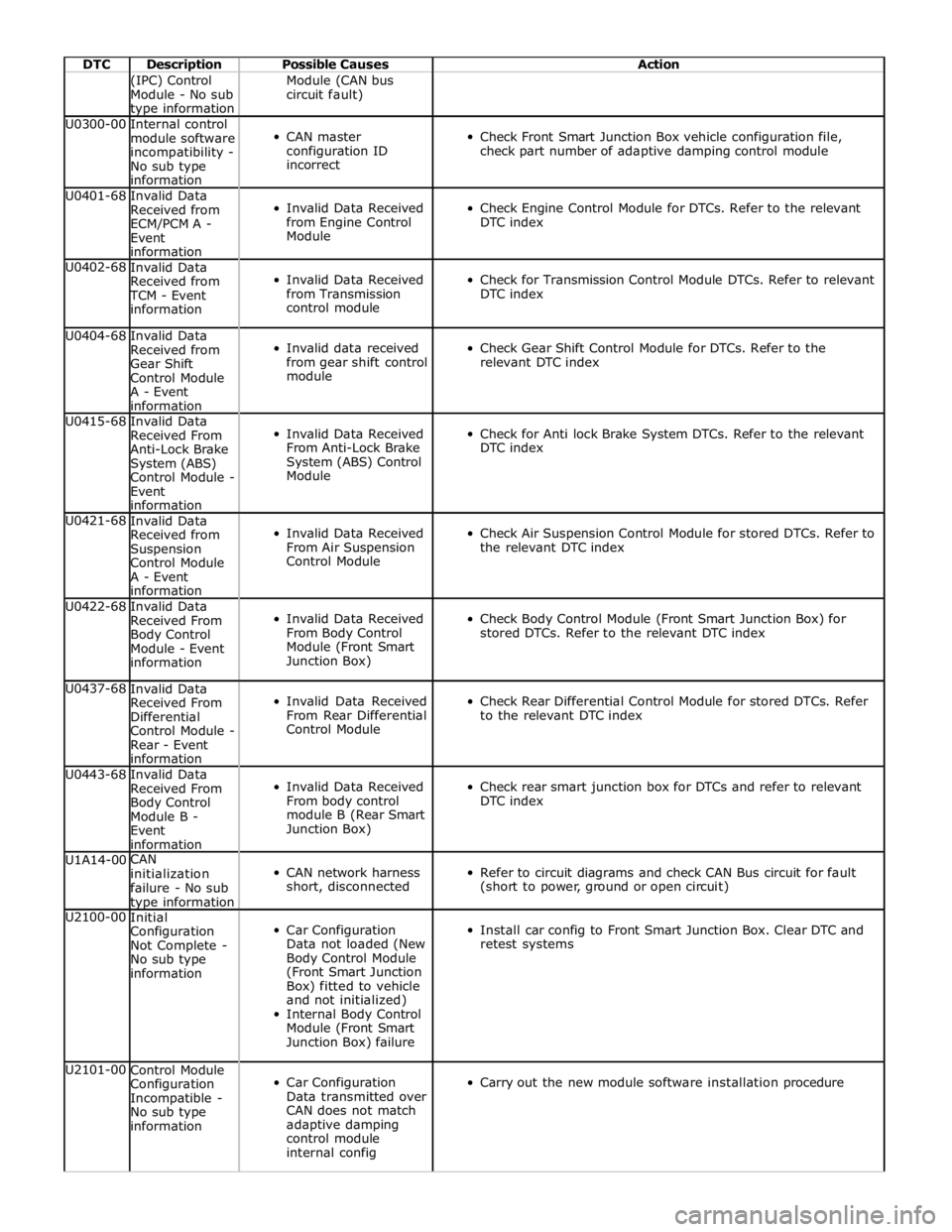
DTC Description Possible Causes Action (IPC) Control
Module - No sub
type information Module (CAN bus
circuit fault) U0300-00
Internal control
module software
incompatibility -
No sub type
information
CAN master
configuration ID
incorrect
Check Front Smart Junction Box vehicle configuration file,
check part number of adaptive damping control module U0401-68
Invalid Data
Received from
ECM/PCM A -
Event
information
Invalid Data Received
from Engine Control
Module
Check Engine Control Module for DTCs. Refer to the relevant
DTC index U0402-68
Invalid Data
Received from TCM - Event
information
Invalid Data Received
from Transmission
control module
Check for Transmission Control Module DTCs. Refer to relevant
DTC index U0404-68
Invalid Data
Received from
Gear Shift
Control Module
A - Event
information
Invalid data received
from gear shift control
module
Check Gear Shift Control Module for DTCs. Refer to the
relevant DTC index U0415-68
Invalid Data
Received From
Anti-Lock Brake
System (ABS)
Control Module -
Event
information
Invalid Data Received
From Anti-Lock Brake
System (ABS) Control
Module
Check for Anti lock Brake System DTCs. Refer to the relevant
DTC index U0421-68
Invalid Data
Received from
Suspension
Control Module
A - Event
information
Invalid Data Received
From Air Suspension
Control Module
Check Air Suspension Control Module for stored DTCs. Refer to
the relevant DTC index U0422-68
Invalid Data
Received From
Body Control
Module - Event
information
Invalid Data Received
From Body Control
Module (Front Smart
Junction Box)
Check Body Control Module (Front Smart Junction Box) for
stored DTCs. Refer to the relevant DTC index U0437-68
Invalid Data
Received From
Differential
Control Module -
Rear - Event
information
Invalid Data Received
From Rear Differential
Control Module
Check Rear Differential Control Module for stored DTCs. Refer
to the relevant DTC index U0443-68
Invalid Data
Received From
Body Control
Module B -
Event
information
Invalid Data Received
From body control
module B (Rear Smart
Junction Box)
Check rear smart junction box for DTCs and refer to relevant
DTC index U1A14-00 CAN
initialization
failure - No sub type information
CAN network harness
short, disconnected
Refer to circuit diagrams and check CAN Bus circuit for fault
(short to power, ground or open circuit) U2100-00
Initial
Configuration
Not Complete -
No sub type
information
Car Configuration
Data not loaded (New
Body Control Module
(Front Smart Junction
Box) fitted to vehicle
and not initialized)
Internal Body Control
Module (Front Smart
Junction Box) failure
Install car config to Front Smart Junction Box. Clear DTC and
retest systems U2101-00
Control Module
Configuration
Incompatible -
No sub type
information
Car Configuration
Data transmitted over
CAN does not match
adaptive damping
control module
internal config
Carry out the new module software installation procedure
Page 119 of 3039
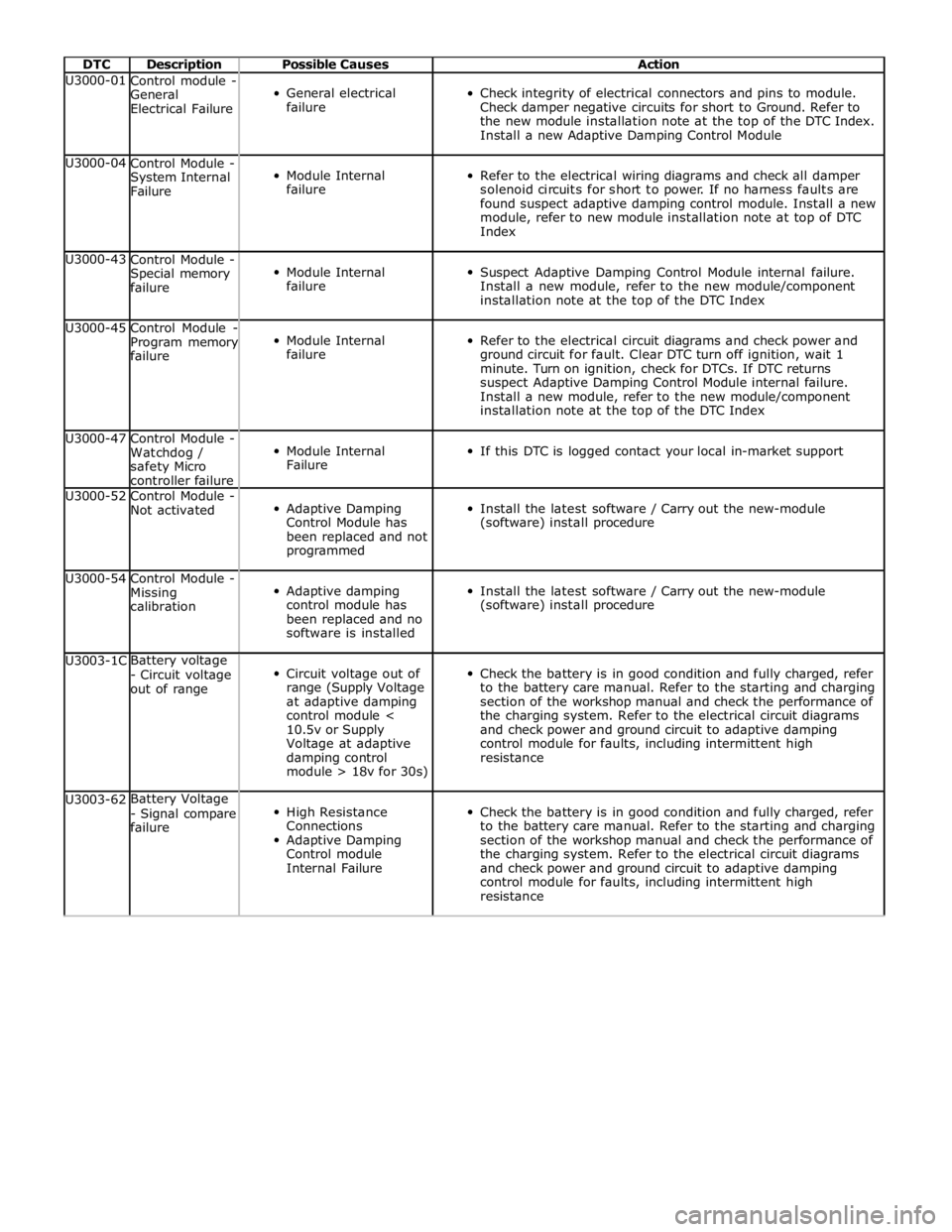
DTC Description Possible Causes Action U3000-01
Control module -
General
Electrical Failure
General electrical
failure
Check integrity of electrical connectors and pins to module.
Check damper negative circuits for short to Ground. Refer to
the new module installation note at the top of the DTC Index.
Install a new Adaptive Damping Control Module U3000-04
Control Module -
System Internal
Failure
Module Internal
failure
Refer to the electrical wiring diagrams and check all damper
solenoid circuits for short to power. If no harness faults are
found suspect adaptive damping control module. Install a new
module, refer to new module installation note at top of DTC
Index U3000-43
Control Module -
Special memory
failure
Module Internal
failure
Suspect Adaptive Damping Control Module internal failure.
Install a new module, refer to the new module/component
installation note at the top of the DTC Index U3000-45
Control Module -
Program memory
failure
Module Internal
failure
Refer to the electrical circuit diagrams and check power and
ground circuit for fault. Clear DTC turn off ignition, wait 1
minute. Turn on ignition, check for DTCs. If DTC returns
suspect Adaptive Damping Control Module internal failure.
Install a new module, refer to the new module/component
installation note at the top of the DTC Index U3000-47
Control Module -
Watchdog /
safety Micro
controller failure
Module Internal
Failure
If this DTC is logged contact your local in-market support U3000-52
Control Module -
Not activated
Adaptive Damping
Control Module has
been replaced and not
programmed
Install the latest software / Carry out the new-module
(software) install procedure U3000-54
Control Module -
Missing
calibration
Adaptive damping
control module has
been replaced and no
software is installed
Install the latest software / Carry out the new-module
(software) install procedure U3003-1C Battery voltage
- Circuit voltage
out of range
Circuit voltage out of
range (Supply Voltage
at adaptive damping
control module <
10.5v or Supply
Voltage at adaptive
damping control
module > 18v for 30s)
Check the battery is in good condition and fully charged, refer
to the battery care manual. Refer to the starting and charging
section of the workshop manual and check the performance of
the charging system. Refer to the electrical circuit diagrams
and check power and ground circuit to adaptive damping
control module for faults, including intermittent high
resistance U3003-62 Battery Voltage
- Signal compare
failure
High Resistance
Connections
Adaptive Damping
Control module
Internal Failure
Check the battery is in good condition and fully charged, refer
to the battery care manual. Refer to the starting and charging
section of the workshop manual and check the performance of
the charging system. Refer to the electrical circuit diagrams
and check power and ground circuit to adaptive damping
control module for faults, including intermittent high
resistance
Page 120 of 3039
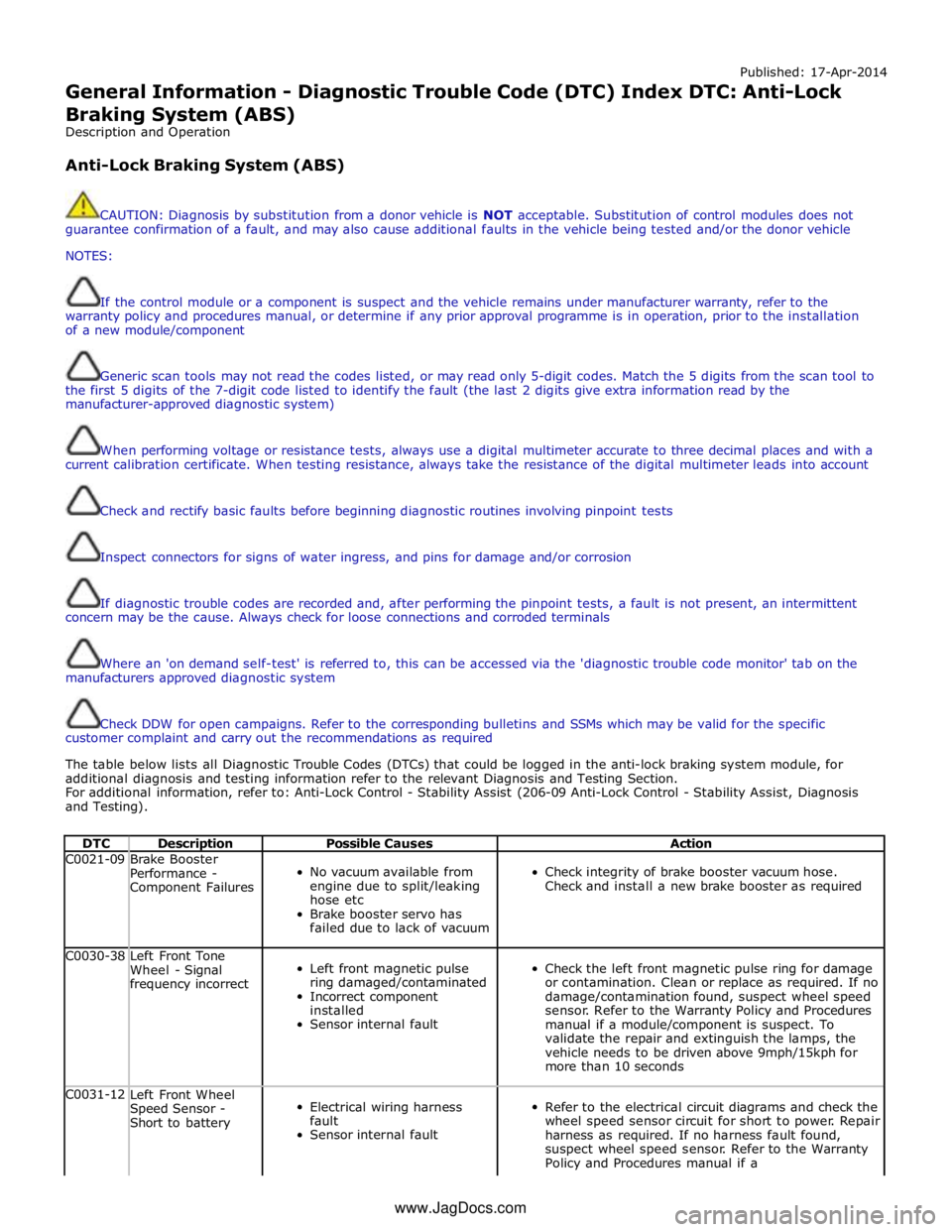
Published: 17-Apr-2014
General Information - Diagnostic Trouble Code (DTC) Index DTC: Anti-Lock Braking System (ABS)
Description and Operation
Anti-Lock Braking System (ABS)
CAUTION: Diagnosis by substitution from a donor vehicle is NOT acceptable. Substitution of control modules does not
guarantee confirmation of a fault, and may also cause additional faults in the vehicle being tested and/or the donor vehicle
NOTES:
If the control module or a component is suspect and the vehicle remains under manufacturer warranty, refer to the
warranty policy and procedures manual, or determine if any prior approval programme is in operation, prior to the installation
of a new module/component
Generic scan tools may not read the codes listed, or may read only 5-digit codes. Match the 5 digits from the scan tool to
the first 5 digits of the 7-digit code listed to identify the fault (the last 2 digits give extra information read by the
manufacturer-approved diagnostic system)
When performing voltage or resistance tests, always use a digital multimeter accurate to three decimal places and with a
current calibration certificate. When testing resistance, always take the resistance of the digital multimeter leads into account
Check and rectify basic faults before beginning diagnostic routines involving pinpoint tests
Inspect connectors for signs of water ingress, and pins for damage and/or corrosion
If diagnostic trouble codes are recorded and, after performing the pinpoint tests, a fault is not present, an intermittent
concern may be the cause. Always check for loose connections and corroded terminals
Where an 'on demand self-test' is referred to, this can be accessed via the 'diagnostic trouble code monitor' tab on the
manufacturers approved diagnostic system
Check DDW for open campaigns. Refer to the corresponding bulletins and SSMs which may be valid for the specific
customer complaint and carry out the recommendations as required
The table below lists all Diagnostic Trouble Codes (DTCs) that could be logged in the anti-lock braking system module, for
additional diagnosis and testing information refer to the relevant Diagnosis and Testing Section.
For additional information, refer to: Anti-Lock Control - Stability Assist (206-09 Anti-Lock Control - Stability Assist, Diagnosis
and Testing).
DTC Description Possible Causes Action C0021-09
Brake Booster
Performance -
Component Failures
No vacuum available from
engine due to split/leaking
hose etc
Brake booster servo has
failed due to lack of vacuum
Check integrity of brake booster vacuum hose.
Check and install a new brake booster as required C0030-38
Left Front Tone
Wheel - Signal
frequency incorrect
Left front magnetic pulse
ring damaged/contaminated
Incorrect component
installed
Sensor internal fault
Check the left front magnetic pulse ring for damage
or contamination. Clean or replace as required. If no
damage/contamination found, suspect wheel speed
sensor. Refer to the Warranty Policy and Procedures
manual if a module/component is suspect. To
validate the repair and extinguish the lamps, the
vehicle needs to be driven above 9mph/15kph for
more than 10 seconds C0031-12
Left Front Wheel
Speed Sensor -
Short to battery
Electrical wiring harness
fault
Sensor internal fault
Refer to the electrical circuit diagrams and check the
wheel speed sensor circuit for short to power. Repair
harness as required. If no harness fault found,
suspect wheel speed sensor. Refer to the Warranty
Policy and Procedures manual if a www.JagDocs.com
Page 125 of 3039
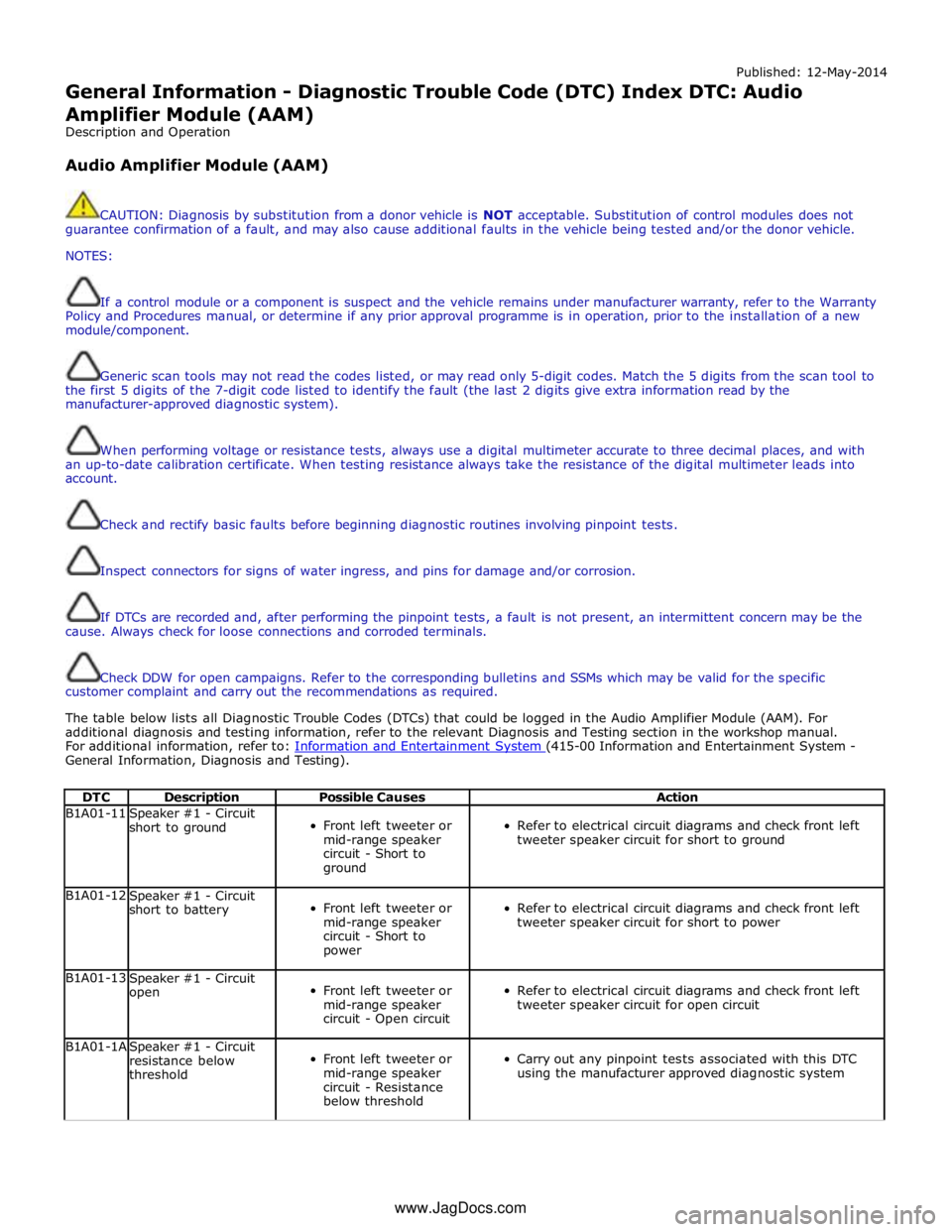
Published: 12-May-2014
General Information - Diagnostic Trouble Code (DTC) Index DTC: Audio Amplifier Module (AAM)
Description and Operation
Audio Amplifier Module (AAM)
CAUTION: Diagnosis by substitution from a donor vehicle is NOT acceptable. Substitution of control modules does not
guarantee confirmation of a fault, and may also cause additional faults in the vehicle being tested and/or the donor vehicle.
NOTES:
If a control module or a component is suspect and the vehicle remains under manufacturer warranty, refer to the Warranty
Policy and Procedures manual, or determine if any prior approval programme is in operation, prior to the installation of a new
module/component.
Generic scan tools may not read the codes listed, or may read only 5-digit codes. Match the 5 digits from the scan tool to
the first 5 digits of the 7-digit code listed to identify the fault (the last 2 digits give extra information read by the
manufacturer-approved diagnostic system).
When performing voltage or resistance tests, always use a digital multimeter accurate to three decimal places, and with
an up-to-date calibration certificate. When testing resistance always take the resistance of the digital multimeter leads into
account.
Check and rectify basic faults before beginning diagnostic routines involving pinpoint tests.
Inspect connectors for signs of water ingress, and pins for damage and/or corrosion.
If DTCs are recorded and, after performing the pinpoint tests, a fault is not present, an intermittent concern may be the
cause. Always check for loose connections and corroded terminals.
Check DDW for open campaigns. Refer to the corresponding bulletins and SSMs which may be valid for the specific
customer complaint and carry out the recommendations as required.
The table below lists all Diagnostic Trouble Codes (DTCs) that could be logged in the Audio Amplifier Module (AAM). For
additional diagnosis and testing information, refer to the relevant Diagnosis and Testing section in the workshop manual.
For additional information, refer to: Information and Entertainment System (415-00 Information and Entertainment System - General Information, Diagnosis and Testing).
DTC Description Possible Causes Action B1A01-11
Speaker #1 - Circuit
short to ground
Front left tweeter or
mid-range speaker
circuit - Short to
ground
Refer to electrical circuit diagrams and check front left
tweeter speaker circuit for short to ground B1A01-12
Speaker #1 - Circuit
short to battery
Front left tweeter or
mid-range speaker
circuit - Short to
power
Refer to electrical circuit diagrams and check front left
tweeter speaker circuit for short to power B1A01-13
Speaker #1 - Circuit
open
Front left tweeter or
mid-range speaker
circuit - Open circuit
Refer to electrical circuit diagrams and check front left
tweeter speaker circuit for open circuit B1A01-1A
Speaker #1 - Circuit
resistance below
threshold
Front left tweeter or
mid-range speaker
circuit - Resistance
below threshold
Carry out any pinpoint tests associated with this DTC
using the manufacturer approved diagnostic system www.JagDocs.com
Page 129 of 3039

DTC Description Possible Causes Action B1A10-1A
Speaker #10 - Circuit
resistance below
threshold
Left subwoofer
speaker circuit -
Resistance below
threshold
Carry out any pinpoint tests associated with this DTC
using the manufacturer approved diagnostic system B1A10-49
Speaker #10 -
Internal electronic
failure
Internal electronic
failure
Suspect the audio amplifier module, check and install a
new module as required, refer to the new
module/component installation note at the top of the
DTC Index B1A11-11
Speaker #11 - Circuit
short to ground
Right subwoofer
speaker circuit - Short
to ground
Refer to electrical circuit diagrams and check right
subwoofer speaker circuit for short to ground B1A11-12
Speaker #11 - Circuit
short to battery
Right subwoofer
speaker circuit - Short
to power
Refer to electrical circuit diagrams and check right
subwoofer speaker circuit for short to power B1A11-13
Speaker #11 - Circuit
open
Right subwoofer
speaker circuit - Open
circuit
Refer to electrical circuit diagrams and check right
subwoofer speaker circuit for open circuit B1A11-1A
Speaker #11 - Circuit
resistance below
threshold
Right subwoofer
speaker circuit -
Resistance below
threshold
Carry out any pinpoint tests associated with this DTC
using the manufacturer approved diagnostic system B1A11-49
Speaker #11 -
Internal electronic
failure
Internal electronic
failure
Suspect the audio amplifier module, check and install a
new module as required, refer to the new
module/component installation note at the top of the
DTC Index U2003-98
Fibre Optic
Communication Bus -
Component or system
over temperature
Component or system
over temperature
Clear DTC and allow system to cool, monitor for
re-occurrence of DTC U3000-05
Control module -
System programming
failures
Software
incompatibility
The version of the
Local Configuration
file does not match
that expected
Re-configure the audio amplifier as an existing control
module, using the manufacturer approved diagnostic
system U3000-42
Control module -
General memory
failure
General memory
failure
Re-configure the audio amplifier as an existing control
module, using the manufacturer approved diagnostic
system. Clear DTC, cycle ignition and read DTCs. If DTC
returns, suspect audio amplifier module and install a
new module. Refer to the new module/component
installation note at the top of the DTC Index U3000-44
Control module - Data
memory failure
Data memory failure
Re-configure the audio amplifier as an existing control
module, using the manufacturer approved diagnostic
system. Clear DTC, cycle ignition and read DTCs. If DTC
returns, suspect audio amplifier module and install a
new module. Refer to the new module/component
installation note at the top of the DTC Index U3000-55
Control Module - Not
configured
Incorrect car
configuration data
received
Check/up-date Car Configuration File using manufacturer
approved diagnostic system U3000-87
Control Module -
Missing message
Missing message
Check CJB for DTCs and refer to DTC Index. Check
information and entertainment module for Car
Configuration File and MOST network DTCs and refer to
relevant DTC Index. Carry out MOST/CAN network tests
using the manufacturer approved diagnostic system
Page 131 of 3039
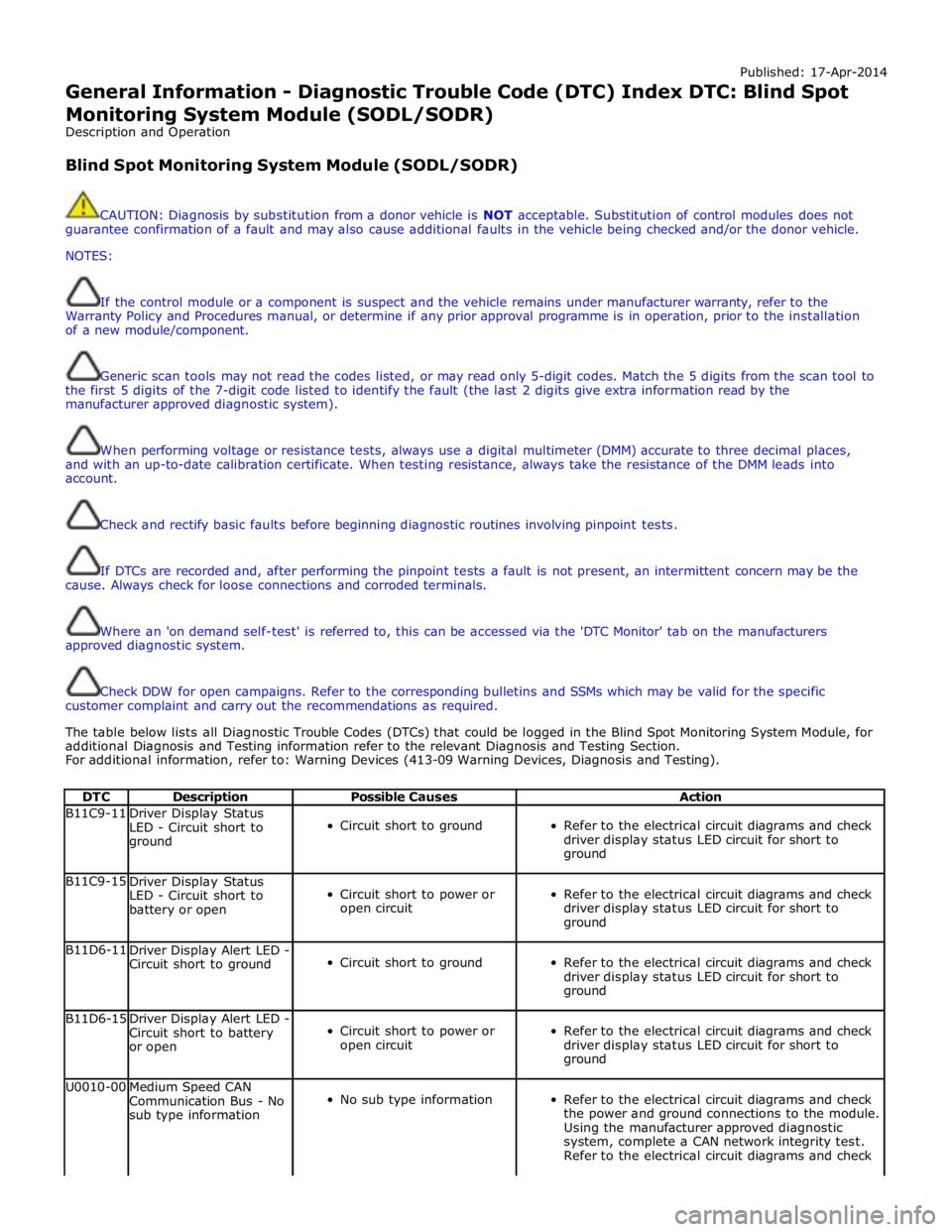
Published: 17-Apr-2014
General Information - Diagnostic Trouble Code (DTC) Index DTC: Blind Spot Monitoring System Module (SODL/SODR)
Description and Operation
Blind Spot Monitoring System Module (SODL/SODR)
CAUTION: Diagnosis by substitution from a donor vehicle is NOT acceptable. Substitution of control modules does not
guarantee confirmation of a fault and may also cause additional faults in the vehicle being checked and/or the donor vehicle.
NOTES:
If the control module or a component is suspect and the vehicle remains under manufacturer warranty, refer to the
Warranty Policy and Procedures manual, or determine if any prior approval programme is in operation, prior to the installation
of a new module/component.
Generic scan tools may not read the codes listed, or may read only 5-digit codes. Match the 5 digits from the scan tool to
the first 5 digits of the 7-digit code listed to identify the fault (the last 2 digits give extra information read by the
manufacturer approved diagnostic system).
When performing voltage or resistance tests, always use a digital multimeter (DMM) accurate to three decimal places,
and with an up-to-date calibration certificate. When testing resistance, always take the resistance of the DMM leads into
account.
Check and rectify basic faults before beginning diagnostic routines involving pinpoint tests.
If DTCs are recorded and, after performing the pinpoint tests a fault is not present, an intermittent concern may be the
cause. Always check for loose connections and corroded terminals.
Where an 'on demand self-test' is referred to, this can be accessed via the 'DTC Monitor' tab on the manufacturers
approved diagnostic system.
Check DDW for open campaigns. Refer to the corresponding bulletins and SSMs which may be valid for the specific
customer complaint and carry out the recommendations as required.
The table below lists all Diagnostic Trouble Codes (DTCs) that could be logged in the Blind Spot Monitoring System Module, for
additional Diagnosis and Testing information refer to the relevant Diagnosis and Testing Section.
For additional information, refer to: Warning Devices (413-09 Warning Devices, Diagnosis and Testing).
DTC Description Possible Causes Action B11C9-11
Driver Display Status
LED - Circuit short to
ground
Circuit short to ground
Refer to the electrical circuit diagrams and check
driver display status LED circuit for short to
ground B11C9-15
Driver Display Status
LED - Circuit short to
battery or open
Circuit short to power or
open circuit
Refer to the electrical circuit diagrams and check
driver display status LED circuit for short to
ground B11D6-11
Driver Display Alert LED -
Circuit short to ground
Circuit short to ground
Refer to the electrical circuit diagrams and check
driver display status LED circuit for short to
ground B11D6-15
Driver Display Alert LED -
Circuit short to battery
or open
Circuit short to power or
open circuit
Refer to the electrical circuit diagrams and check
driver display status LED circuit for short to
ground U0010-00
Medium Speed CAN
Communication Bus - No
sub type information
No sub type information
Refer to the electrical circuit diagrams and check
the power and ground connections to the module.
Using the manufacturer approved diagnostic
system, complete a CAN network integrity test.
Refer to the electrical circuit diagrams and check
Page 132 of 3039

DTC Description Possible Causes Action the CAN network U0140-00
Lost Communication
With Body Control
Module - No sub type
information
No sub type information
Refer to the electrical circuit diagrams and check
the power and ground connections to the module.
Using the manufacturer approved diagnostic
system, complete a CAN network integrity test.
Refer to the electrical circuit diagrams and check
the CAN network between the Central Junction
Box and Blind Spot Monitoring System Module U0155-00
Lost Communication
With Instrument Panel
Cluster (IPC) Control
Module - No sub type
information
No sub type information
Refer to the electrical circuit diagrams and check
the power and ground connections to the module.
Using the manufacturer approved diagnostic
system, complete a CAN network integrity test.
Refer to the electrical circuit diagrams and check
the CAN network between the Instrument Cluster
and Blind Spot Monitoring System Module U0232-00
Lost Communication
With Blind Spot
Monitoring System
Module - Left - No sub
type information
CAN bus circuit fault
Harness fault between left
side mirror and left side
module
Refer to the electrical circuit diagrams and check
the power and ground connections to the module.
Using the manufacturer approved diagnostic
system, complete a CAN network integrity test.
Refer to the electrical circuit diagrams and check
the CAN network between the left Blind Spot
Monitoring System Module and the right Blind
Spot Monitoring System Module
Refer to the electrical circuit diagrams and check
the left side harness between the left side mirror
and left hand module U0233-00
Lost Communication
With Blind Spot
Monitoring System
Module - Right - No sub
type information
CAN bus circuit fault
Harness fault between
right side mirror and right
side module
Refer to the electrical circuit diagrams and check
the power and ground connections to the module.
Using the manufacturer approved diagnostic
system, complete a CAN network integrity test.
Refer to the electrical circuit diagrams and check
the CAN network between the left Blind Spot
Monitoring System Module and the right Blind
Spot Monitoring System Module
Refer to the electrical circuit diagrams and check
the right side harness between the right side
mirror and right hand module U0300-00
Internal Control Module
Software Incompatibility
- No sub type
information
No sub type information
Check Central Junction Box for related DTCs and
refer to the relevant DTC Index. Check Restraints
Control Module for related DTCs and refer to DTC
Index. Check correct components are installed
and that the latest software version is installed U0415-68
Invalid Data Received
From Anti-Lock Brake
System (ABS) Control
Module - event
information
Event information
Using the manufacturer approved diagnostic
system check the central junction box and the
anti-lock brake system (ABS) control module for
related DTCs and refer to the relevant DTC Index U0422-68
Invalid Data Received
From Body Control
Module - Event
information
Event information
Check the Central Junction Box for related DTCs
and refer to the relevant DTC index U2100-00
Initial Configuration Not
Complete - No sub type
information
Car Configuration File
information not received
completely
Check/amend Car Configuration File using
manufacturer approved diagnostic system U2101-00
Control Module
Configuration
Incompatible - No sub
type information
Car Configuration File
information incompatible
to Control module
Check/amend Car Configuration File using
manufacturer approved diagnostic system U3000-44
Control Module - Data
memory failure
Control module data
memory failure
Refer to the electrical circuit diagrams and check
the power and ground circuits to the component.
Refer to the warranty policy and procedures
manual if a module is suspect
Page 133 of 3039

DTC Description Possible Causes Action U3000-47
Control Module -
Watchdog/safety
microcontroller failure
Control module internal
watchdog/safety
MicroController failure
Refer to the electrical circuit diagrams and check
the power and ground circuits to the component.
Refer to the warranty policy and procedures
manual if a module is suspect U3000-49
Control Module - Internal
electronic failure
Control module internal
electronic failure (internal
error)
Clear DTC, cycle ignition and retest. If fault
persists, refer to the electrical circuit diagrams
and check the power and ground circuits to the
component. Repair as required, clear DTC and
retest
If fault persists, check and install a new
blindspot monitoring control module as required.
Refer to the warranty policy and procedures
manual if a module is suspect U3003-62
Battery Voltage - Signal
compare failure
Mis-match in battery
voltage, between Central
Junction Box and Blind
Spot Monitoring System
module, of 2 volts or more
Check the module connector for security and
integrity. Refer to the electrical circuit diagrams
and check the Control module supply voltage.
Check vehicle battery voltage and state of
charge. Check the power signal line to the
module
Page 134 of 3039
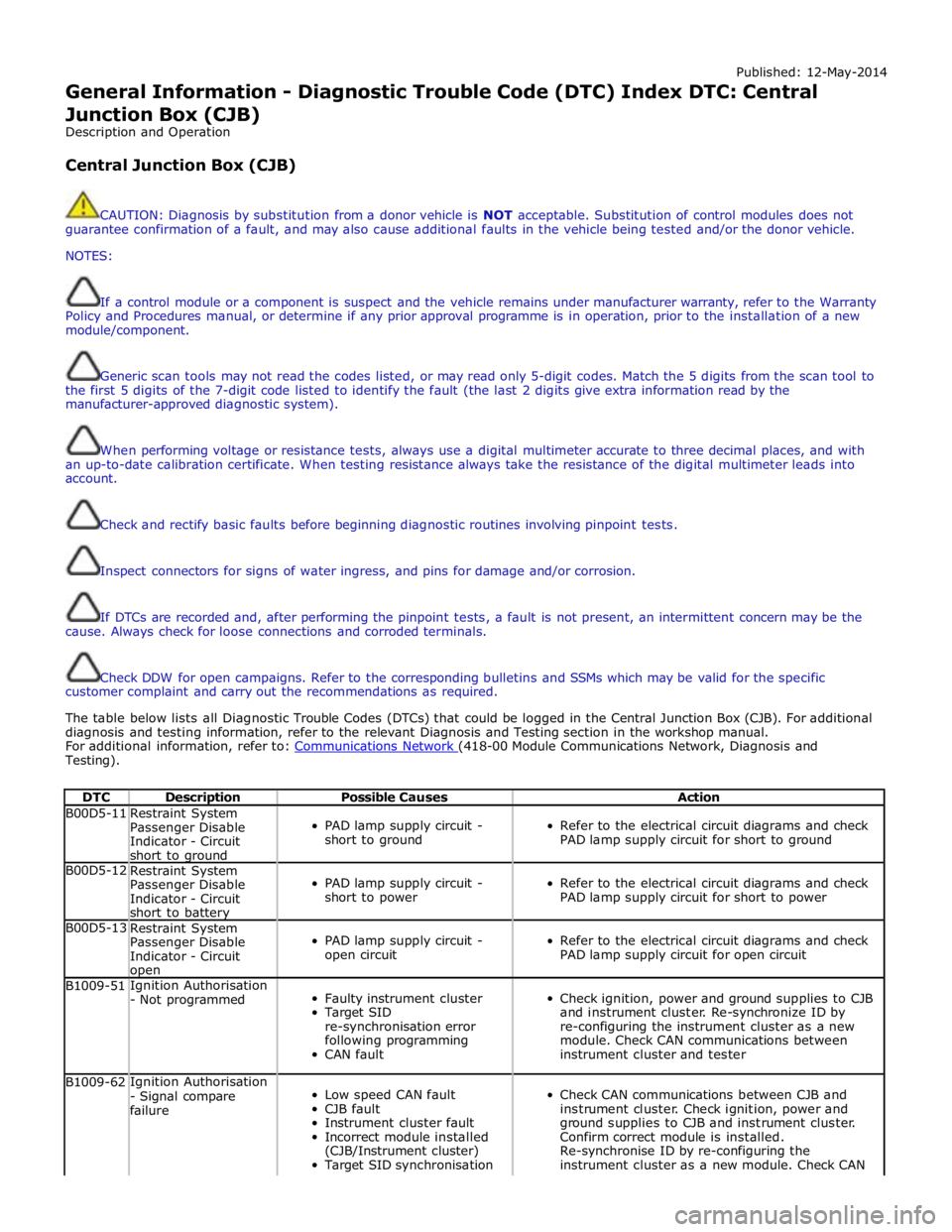
Published: 12-May-2014
General Information - Diagnostic Trouble Code (DTC) Index DTC: Central Junction Box (CJB)
Description and Operation
Central Junction Box (CJB)
CAUTION: Diagnosis by substitution from a donor vehicle is NOT acceptable. Substitution of control modules does not
guarantee confirmation of a fault, and may also cause additional faults in the vehicle being tested and/or the donor vehicle.
NOTES:
If a control module or a component is suspect and the vehicle remains under manufacturer warranty, refer to the Warranty
Policy and Procedures manual, or determine if any prior approval programme is in operation, prior to the installation of a new
module/component.
Generic scan tools may not read the codes listed, or may read only 5-digit codes. Match the 5 digits from the scan tool to
the first 5 digits of the 7-digit code listed to identify the fault (the last 2 digits give extra information read by the
manufacturer-approved diagnostic system).
When performing voltage or resistance tests, always use a digital multimeter accurate to three decimal places, and with
an up-to-date calibration certificate. When testing resistance always take the resistance of the digital multimeter leads into
account.
Check and rectify basic faults before beginning diagnostic routines involving pinpoint tests.
Inspect connectors for signs of water ingress, and pins for damage and/or corrosion.
If DTCs are recorded and, after performing the pinpoint tests, a fault is not present, an intermittent concern may be the
cause. Always check for loose connections and corroded terminals.
Check DDW for open campaigns. Refer to the corresponding bulletins and SSMs which may be valid for the specific
customer complaint and carry out the recommendations as required.
The table below lists all Diagnostic Trouble Codes (DTCs) that could be logged in the Central Junction Box (CJB). For additional
diagnosis and testing information, refer to the relevant Diagnosis and Testing section in the workshop manual.
For additional information, refer to: Communications Network (418-00 Module Communications Network, Diagnosis and Testing).
DTC Description Possible Causes Action B00D5-11
Restraint System
Passenger Disable
Indicator - Circuit
short to ground
PAD lamp supply circuit -
short to ground
Refer to the electrical circuit diagrams and check
PAD lamp supply circuit for short to ground B00D5-12
Restraint System
Passenger Disable
Indicator - Circuit
short to battery
PAD lamp supply circuit -
short to power
Refer to the electrical circuit diagrams and check
PAD lamp supply circuit for short to power B00D5-13
Restraint System
Passenger Disable
Indicator - Circuit open
PAD lamp supply circuit -
open circuit
Refer to the electrical circuit diagrams and check
PAD lamp supply circuit for open circuit B1009-51 Ignition Authorisation
- Not programmed
Faulty instrument cluster
Target SID
re-synchronisation error
following programming
CAN fault
Check ignition, power and ground supplies to CJB
and instrument cluster. Re-synchronize ID by
re-configuring the instrument cluster as a new
module. Check CAN communications between
instrument cluster and tester B1009-62 Ignition Authorisation
- Signal compare
failure
Low speed CAN fault
CJB fault
Instrument cluster fault
Incorrect module installed
(CJB/Instrument cluster)
Target SID synchronisation
Check CAN communications between CJB and
instrument cluster. Check ignition, power and
ground supplies to CJB and instrument cluster.
Confirm correct module is installed.
Re-synchronise ID by re-configuring the
instrument cluster as a new module. Check CAN